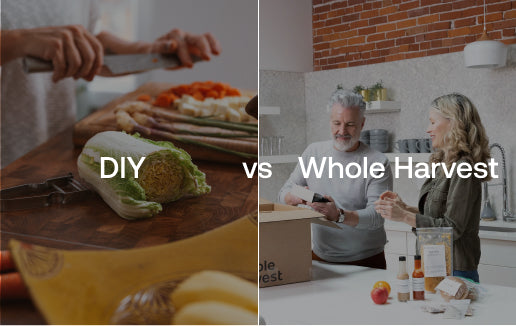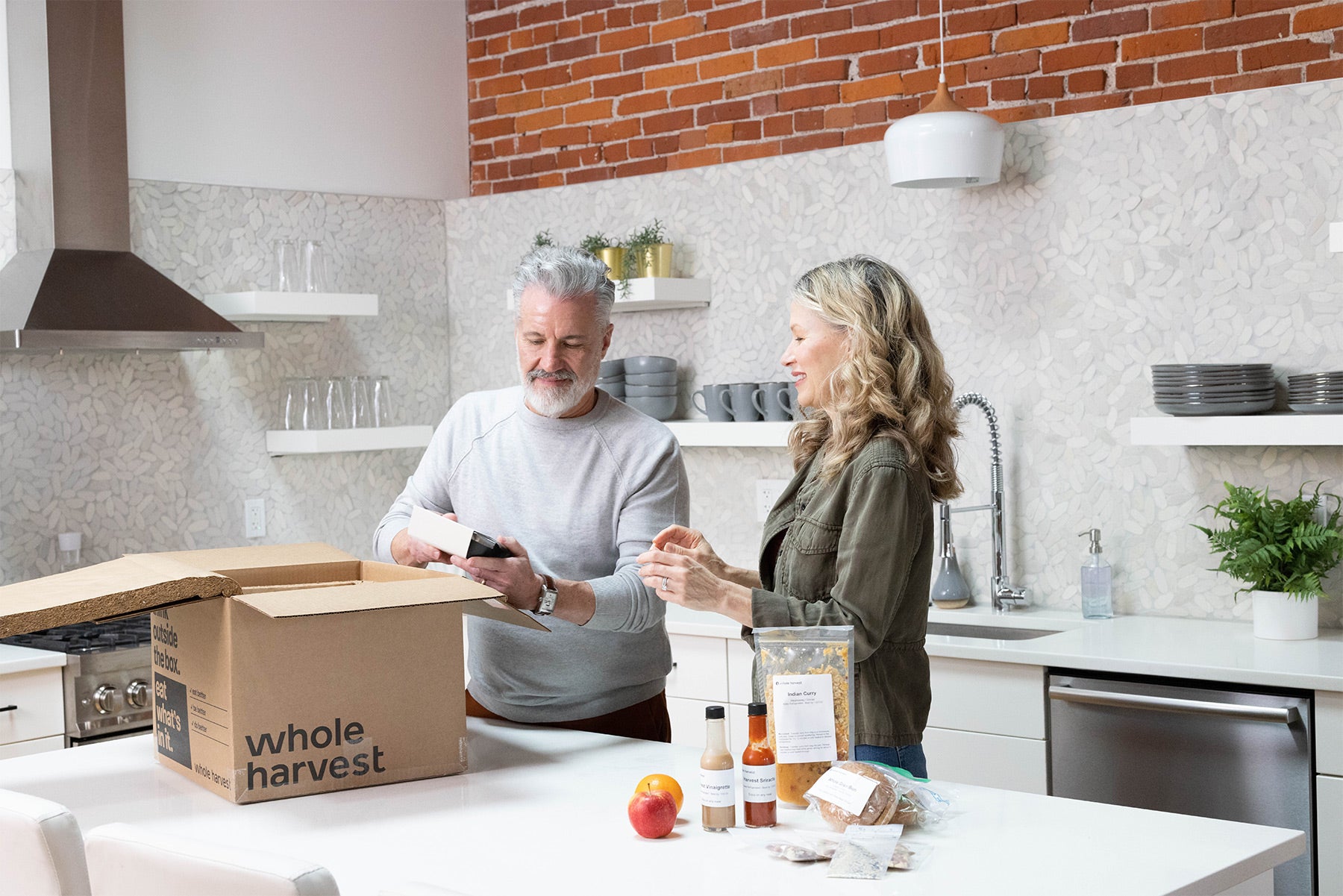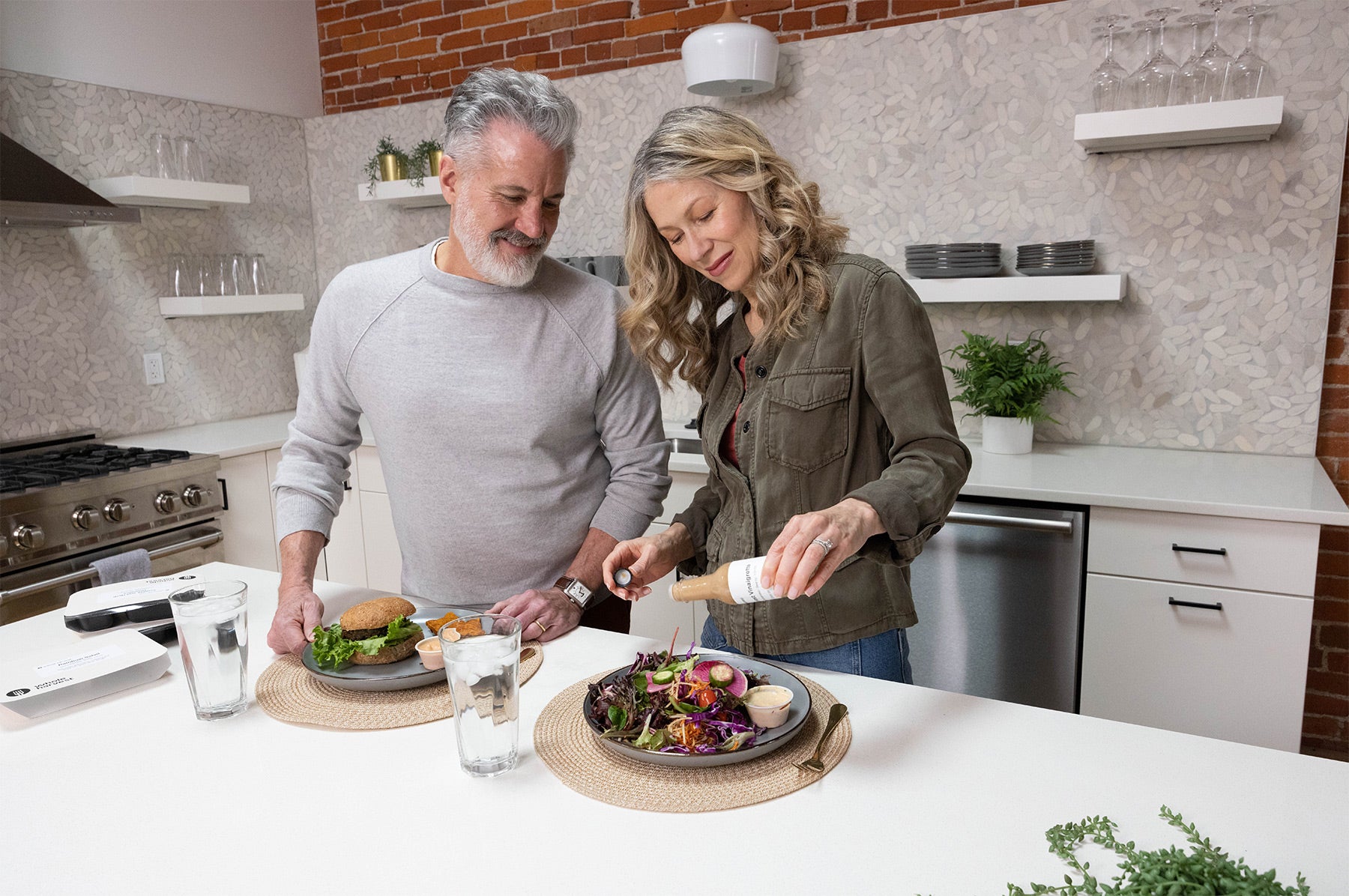Cost Comparison for Whole Harvest vs. Do It Yourself

I love the idea of plant-based meal delivery service, but I’m not always ready to pay for it. The eternal struggle for most people considering a new service, especially a specialty one like Whole Harvest’s whole food plant-based meal delivery, is deciding if it’s worth the cost.
Up front, the cost of meal delivery seems like a lot, but is it?
Well, I work here, and I still wanted to see if I could beat our numbers. I’m independent, thrifty, and stubborn that way, so I decided to take on an experiment.
I wanted to see if a do-it-yourself approach to prepping and cooking oil-free whole food plant-based meals could beat paying to have them shipped to my front door.

The Answer to Do-It-Yourself VS Meal Delivery Service for WFPB Is More Important Than You Might Think
Many people follow a WFPB diet out of necessity because of a health condition. For them, the stakes of successfully following the diet is high, and the obstacles before them are substantial. Many people burnout on the work required to research recipes, shop for ingredients, prep, and cook their meals.
The same is true for people who eat WFPB by choice. What seems like a wonderful, healthy choice quickly turns into a chore.
IF the ready-to-eat meal delivery model turns out to be financially and practically sound, it solves a big problem for people embracing a WFPB diet.
Let’s find out…
What Is the Whole Harvest WFPB Meal Delivery Model?
First, before this throwdown between the DIY spirit and convenience, let’s get a good look at the competition.

Whole Harvest is the gold standard in whole food plant-based meal delivery, hands down. They’ve gone all in on WFPB without compromise.
They promise…
- 100% Whole Food Plant-Based meals without any artificial ingredients, added sugar, excess sodium, or any shortcuts whatsoever.
- 100% Fresh ready-to-eat meals that arrive in packaging that surpasses nearly any other service out there. Whole Harvest’s vacuum-sealed entrees preserve flavor and freshness like nothing else.
- 100% Oil-Free food prep. Oil-free food prep is incredibly hard to find, even in WFPB circles, but for many people addressing health concerns, it’s essential.
In addition, most meals are also gluten-free and many are compliant with the SOS-Free diet (Salt-Oil-Sugar).
Meanwhile, every meal is ready-to-eat. The meals that need to be heated are ready in 2-3 minutes in the microwave.
Most importantly, the meals are truly delicious, with recipes developed by an innovative culinary team working at the cutting edge of WFPB cuisine.
All of these elements add up to one big advantage for people eating oil-free whole food plant-based:
Control.
Whole Harvest customers get total control over…
- What they eat and their ability to go 100% all-in on WFPB.
- How easy their access is to the food they need.
- How good it tastes and how much variety they enjoy from meal-to-meal.
That’s what we’re trying to beat in our DIY experiment - purity of the experience and a lot of convenience.
The Challenge: See if DIY Can Beat Whole Harvest’s Custom WFPB Meal Delivery Box

For this challenge, I chose to try and beat an 8-meal custom delivery box from Whole Harvest.
Whole Harvest offers custom delivery boxes as either one-time orders or subscriptions. With their new, vacuum-sealed meals you can actually order up to 21 ready-to-eat meals.
The vacuum-sealed tech keeps them fresh for an impressively long time and makes it possible to freeze them as well, so many customers use their custom boxes to stock up.
You can pick any meals you like. For this exercise I chose…
- Wholesome Lentil Loaf
- Teriyaki Vegetables and Tofu
- Southwest Comfort Mac
- Savory Mushroom Bolognese
- Shepherd’s Pie
- Pasta Fagioli
- Jackfruit Enchiladas
- All-American Burger with Potato Salad

Here was the mission.
I would follow our culinary team’s recipes to the letter. Admittedly, this is already an unfair advantage as most DIY approaches require you to do research on recipes, so we’ll be tracking the tasks of shopping, prepping, and cooking the meals.
Now, to truly understand the value of the meal delivery service vs DIY, we can’t just look at cost. We need to look at two criteria.
- The cost of ingredients.
- The time it takes to do this on your own.
After all, our time is valuable. How big of an impact would this have on my week?
Whole Harvest Meal Delivery VS DIY Test #1 - The Cost of Ingredients
I shopped primarily at Whole Foods Market for these items because Whole Harvest uses primarily organic ingredients, and this seemed like a good place to start. Whole Harvest actually sources its ingredients from local farmers and strives for farm-to-table whenever possible.

The total cost at Whole Foods Market for 8 meals for the ingredients was $169.91. I had to go to a second grocery store for a couple of the ingredients that Whole Foods didn’t have in stock. The total at the 2nd grocery store was $6.43.
The total grocery bill was $176.34
That’s about $22 per meal. Now, most of these meals have a large enough servings for two people, which helps.
Now, let’s look at the Whole Harvest side.
- My cost for this custom meal delivery box at the time of publishing is $107.20.
- If I opt-in for weekly subscription I save another 5%, which makes it $102.13.
- To be fair, there are shipping costs, which currently range from $12.99 to $29.99 depending on where you are in the United States.
So, Whole Harvest’s weekly meal delivery costs for these 8 meals will range between $115.12 and $137.19 on the outside.
You could probably make some argument about paying Whole Foods prices for ingredients, but you’d still have at least a $39.15 gap to close for the costs to be even.
To my surprise, so far, Whole Harvest was winning, and I’d already spent about 90 minutes shopping, including driving to the two different stores.
Whole Harvest Meal Delivery VS DIY Test #2 - Time to Prep and Cook

OK, if we’re being honest, there’s no contest here between heating a ready-to-eat meal for 2-3 minutes (prepared by a professional culinary chef) and prepping and cooking your own.
However, our conversation needs to be more nuanced than this. For many people, there’s a threshold of convenience where it makes sense personally to do-it-yourself, so let’s dig in for a moment to see how my experiment turned out.
For the 8 meals I chose to attempt to replicate, the prep time averaged about an hour per meal. Some of the items took less time to prep, and some items took me to the point of nearly throwing it all away in frustration.
That was just the prep time.
If you want to grade me on a curve, I was new to all of this. Some folks might be faster, but in making these meals from scratch, the amount of chopping, etc. is not to be underestimated.
In the end, here’s where I landed…
| Phase | Time |
| Shop | 1 hour and 30 minutes |
| Prep | 5 hours and 40 minutes |
| Cook | 6 hours and 5 minutes |
| Total time | 13 hours and 15 minutes |
Ouch.
Much of the cooking time is in the oven. I can multitask during that time. But still, ouch. I’m barely getting my pets fed and the dishes done as it is.
Final Stats and the Do-It-Yourself Elephant In the Room

| Cost | Time | |
| (DYI) Do-it-Yourself | $176.34 | 13+ hours |
| Whole Harvest ready-to-Eat Meal Delivery | $137.19 (max) | 2-3 minutes per meal |
And here’s the do-it-yourself elephant in the room. This was only 8 meals - 4 lunches and 4 dinners, or however you want to break it out.
What about the rest of the week?
For some people, this is just the boost they need. Covering most of your dinners and lunches in a week could be the perfect amount of help. Other folks might need all 21 meals covered for the week.
The bottom line is, there’s substantial value in both the money and time saved by using Whole Harvest’s meal delivery service to support a whole food plant-based diet.
Honestly, I’d always sort of thought of our meal-delivery product as a luxury and hadn’t realized how accessible and practical it really is!
The Stuff You Can’t Put a Price On
I’m happy to see the place I work for really delivers value in terms of time and money, but then, I started to think about all of the other things I gained by ordering meals from Whole Harvest.
- 100% Assurance the meals are truly whole food plant-based and cooked by experts who know how to balance the nutritional components.
- Food cooked by experts in oil-free cooking, which is tricky.
- Delicious food cooked by experts who know how to really bring out the flavor in veggies.
- Flexibility with vacuum-sealed entrees that would last a long time and let me stock up. Call me crazy, but I don’t have an industrial vacuum-sealing machine at home, and my leftovers are just as vulnerable as anyone else’s.
- Freedom to spend my time on other things. That’s a big one. I don’t want my whole life, or my spare time at least, to become all about my desire to win the DIY game in eating WFPB meals.
For me, this whole journey really did come back to control - control over costs, convenience, and quality of life.
I’m glad I took on this experiment, and I really hope it helps you think things through as well. Whether it’s by necessity or choice, your quest to eat whole food plant-based should be one that improves your quality of life, and that includes HOW you conquer the challenge of eating in a new way.
Whole Harvest exists to be your partner in the WFPB journey, and we’ve worked hard to create a sustainable, practical solution for you to use.
If you’re ready to take control of your health, we’ve got your back like no one else.

